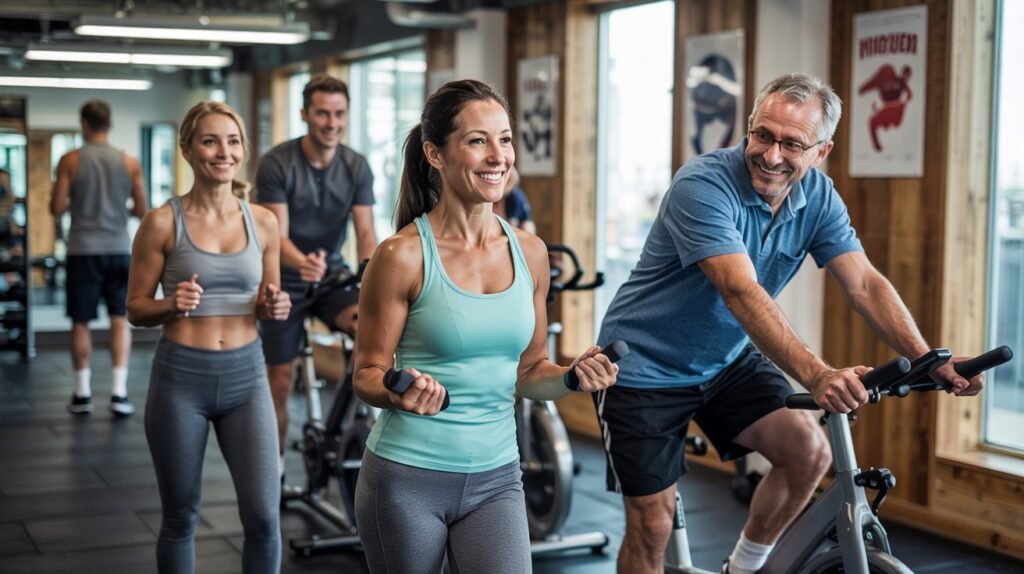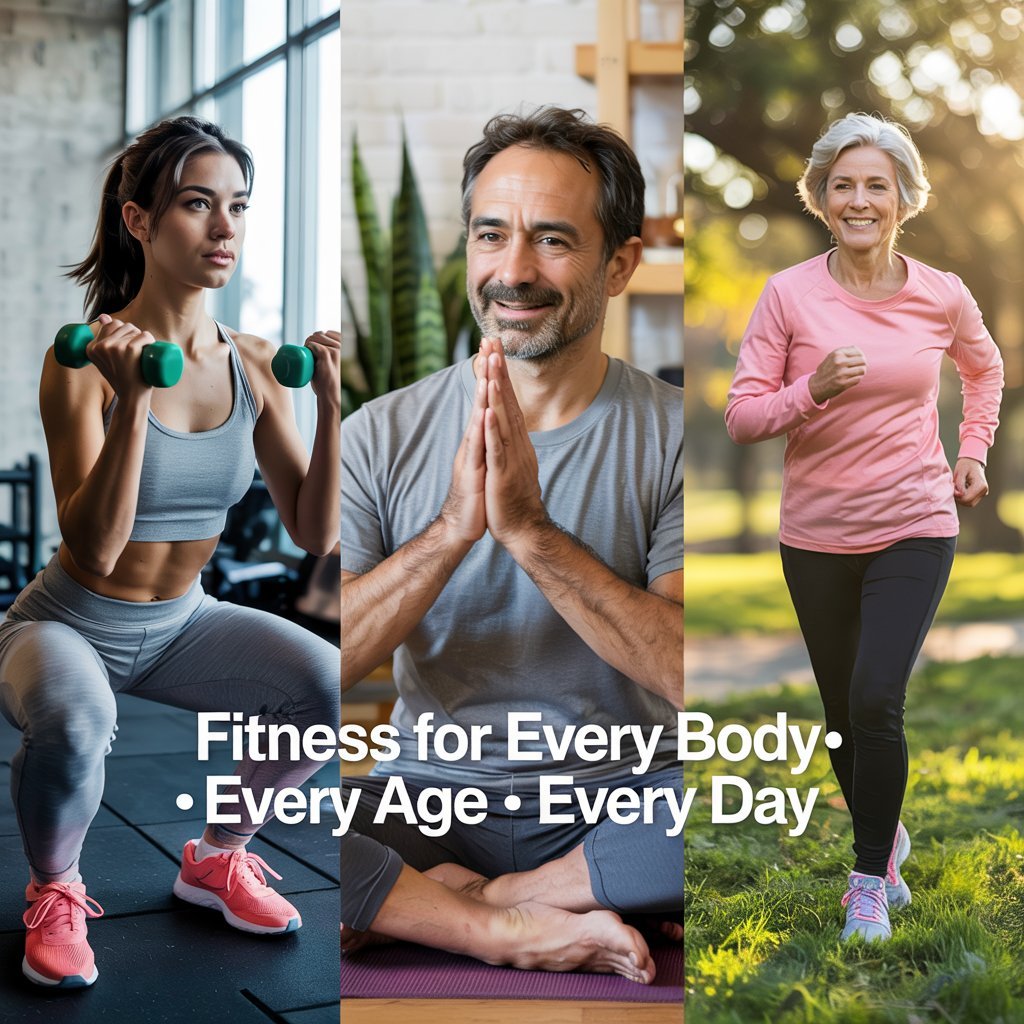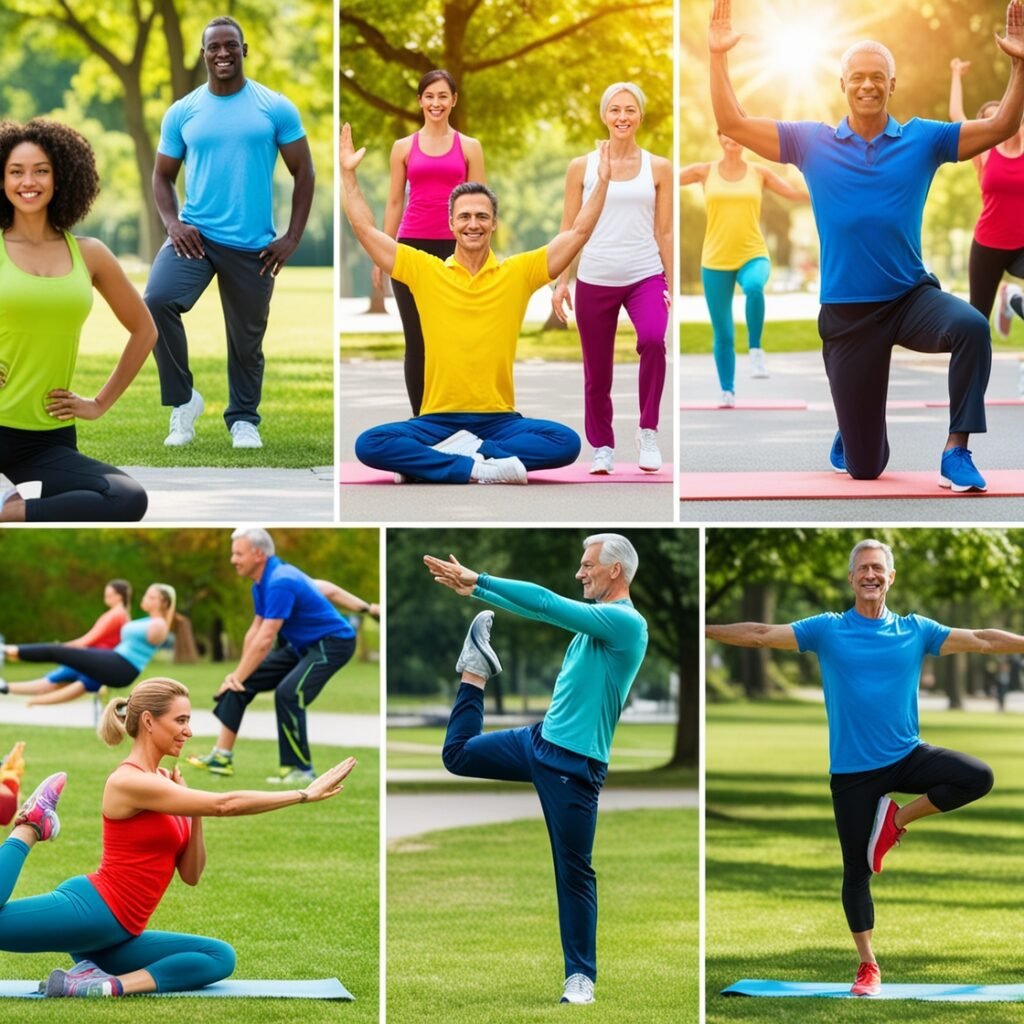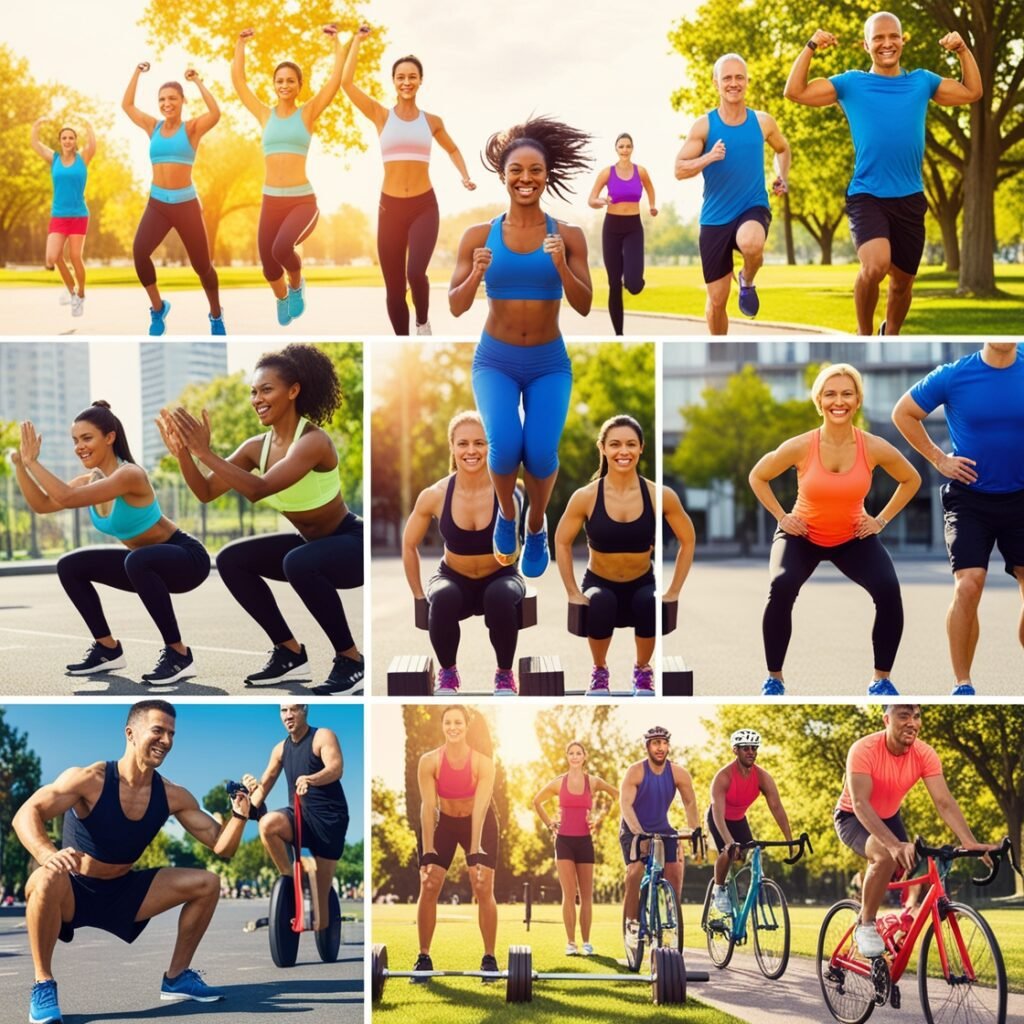Table of Contents
Introduction
What if the secret to more energy, confidence, and longevity wasn’t a miracle pill—but something you already have access to? Fitness isn’t just about lifting weights or running miles; it’s the foundation of a healthier, happier life. Whether you’re a busy professional, a parent juggling endless tasks, or someone rediscovering movement, the right approach to exercise can transform your physical health, mental clarity, and overall well-being.
But let’s be honest: with endless workout trends, conflicting advice, and hectic schedules, starting a fitness routine can feel overwhelming. How do you balance strength, cardio, and recovery? What’s the truth about nutrition and supplements? And how can you stay motivated when life gets in the way?
In this guide, we’ll cut through the noise and explore:
- Science-backed benefits of fitness—from disease prevention to stress relief.
- Practical strategies to build a balanced routine that fits your lifestyle.
- Mistakes to avoid (like overtraining or skipping rest days) and how to course-correct.
- Pro tips for consistency, whether you prefer gym sessions, outdoor workouts, or home exercises.

The Importance of Fitness for Overall Well-Being
Think about the last time you felt truly energized—not just from caffeine, but from your own vitality. That’s the power of fitness at work. Beyond sculpted muscles or weight loss, regular movement is your body’s best defense against disease, stress, and aging. But why does it matter so much? Let’s break it down.
1. Physical Health: More Than Just a Number on the Scale
Exercise isn’t just about looking good—it’s about functioning at your best. Studies show that consistent physical activity:
- Boosts immunity by promoting circulation and lymphatic flow.
- Strengthens your heart, reducing risks of hypertension and stroke.
- Regulates blood sugar, lowering chances of type 2 diabetes.
- Builds bone density, fighting osteoporosis as you age.
Ever notice how a 30-minute walk can clear brain fog better than an extra cup of coffee? That’s your body thanking you.
2. Mental Health: The Invisible Gym Gains
Your brain thrives on movement. Physical activity:
- Triggers endorphins, nature’s mood lifters (say goodbye to stress!).
- Reduces anxiety and depression—sometimes as effectively as medication.
- Improves sleep quality, helping you wake up refreshed.
“Exercise is a keystone habit—it sparks positive changes across your entire life.”
3. Longevity: Adding Years to Your Life
Want to age gracefully? Fitness is your secret weapon. Research reveals that active adults:
- Live longer—with fewer chronic illnesses.
- Maintain independence by preserving mobility and balance.
- Sharpen cognitive function, delaying conditions like dementia.
Key Components of a Balanced Fitness Routine
Ever wonder why some people get life-changing results from their workouts while others spin their wheels? The secret isn’t magic—it’s balance. A truly effective fitness routine isn’t just about crushing calories or maxing out weights; it’s about combining the right elements to build a stronger, healthier, and more resilient you. Let’s break it down.
1. Strength Training: The Foundation of a Powerful Body
Think strength training is just for bodybuilders? Think again. Incorporating resistance work into your routine:
- Builds lean muscle, boosting metabolism even at rest
- Strengthens bones, reducing injury risk as you age
- Improves functional fitness (think: carrying groceries or playing with kids)
Pro Tip: Start with 2-3 sessions weekly, focusing on compound movements like squats, push-ups, and rows.
2. Cardiovascular Exercise: Your Heart’s Best Friend
Whether you love running, cycling, or dancing, cardio does more than burn calories—it:
- Enhances heart and lung health
- Boosts endurance for everyday activities
- Releases mood-elevating endorphins
“Mix it up! Try HIIT for efficiency or steady-state cardio for active recovery days.”
3. Flexibility & Mobility: The Often-Forgotten Game Changer
Can’t touch your toes? You’re not alone—but you shouldn’t ignore it. Dedicated mobility work:
- Prevents injuries by improving joint range of motion
- Corrects posture from hours at a desk
- Enhances performance in other workouts
Try This: Spend 5-10 minutes daily on dynamic stretches or yoga flows.

Putting It All Together
The magic happens when these elements work in harmony:
- Beginner: 3 days strength + 2 days cardio + daily mobility
- Intermediate: 4 days strength (split routines) + 3 days cardio (varied intensity)
- Advanced: Periodized training with dedicated mobility sessions
Setting Realistic Fitness Goals For A Sustainable Success
We’ve all been there – that burst of motivation where we vow to work out seven days a week, eat perfectly, and transform our bodies in a month. But how often does that actually work? The truth is, lasting results come from setting goals that challenge you without breaking you. Let’s explore how to create fitness targets that set you up for success rather than frustration.
Why SMART Goals Beat Vague Resolutions
The SMART framework turns wishful thinking into actionable plans:
- Specific: “Get stronger” → “Perform 10 proper push-ups”
- Measurable: “Lose weight” → “Lose 1 pound per week”
- Achievable: “Run a marathon next month” → “Run a 5K in 3 months”
- Relevant: “Do what my friend is doing” → “Choose activities I enjoy”
- Time-bound: “Exercise more” → “Work out 3x/week for 30 days”
Pro Tip: Start with 2-3 SMART goals max to avoid overwhelm.
Tracking Progress: Beyond the Scale
Numbers tell only part of the story. Try these more meaningful metrics:
✅ Performance: Can you lift heavier? Run farther? Move with better form?
✅ Energy Levels: Notice better sleep or afternoon slumps disappearing?
✅ Clothing Fit: That shirt fitting better is progress too!
✅ Consistency: Celebrate showing up 3x/week for a month straight
“What gets measured gets managed. But what gets celebrated gets repeated.”
Breaking Through Plateaus (Without Losing Motivation)
Hit a wall? These strategies work:
- Micro-Progressions: Add just 2.5 lbs to your lifts or 30 seconds to your runs
- Activity Swaps: Try swimming instead of running to shock your muscles
- Deload Weeks: Reduce intensity by 30% every 4-6 weeks to recover
- Non-Fitness Wins: Notice improved mood, focus, or stress resilience
The Motivation Hack: Pair workouts with something you love (audiobooks, podcasts, or your favorite playlist).
Your Action Plan
- Write Down 2 SMART goals for the next 30 days
- Choose 2 tracking methods beyond weight (photos, measurements, workout logs)
- Schedule regular check-ins (weekly quick reviews, monthly deeper assessments)
Nutrition and Hydration for Optimal Performance
You wouldn’t put low-grade fuel in a high-performance car—so why do we often shortchange our bodies when it comes to nutrition? Whether you’re lifting weights, running miles, or just trying to stay active, what you eat and drink is the invisible workout partner you can’t afford to ignore. Let’s cut through the diet noise and focus on what really works.
Pre-Workout Nutrition: Your Body’s Launchpad
Timing & Composition Matters:
- 30-60 minutes before exercise: Opt for easily digestible carbs + light protein
- Banana with almond butter
- Greek yogurt with berries
- Oatmeal with a scoop of protein powder
- Avoid: Heavy fats or excessive fiber (they slow digestion)
Pro Tip: Hydrate with 16-20 oz of water 2 hours pre-workout to optimize performance.
Post-Workout Recovery: The Golden Window
Refuel Within 30-60 Minutes:
- Protein (20-30g) to repair muscles
- Carbs to replenish glycogen stores
- Electrolytes to rehydrate effectively
“Your post-workout meal is like hitting the ‘save’ button on your progress.”
Staying Hydrated: The Often-Overlooked Performance Booster
Signs You’re Underhydrated:
- Fatigue during workouts
- Muscle cramps
- Dark yellow urine
Hydration Guidelines:
- Daily: ½-1 oz water per pound of body weight
- During Exercise: 7-10 oz every 10-20 minutes
- After: Replace each pound lost with 16-24 oz fluid
Supplements: Helpful or Hype?
Evidence-Based Options:
- Protein Powder (when whole food isn’t convenient)
- Creatine (proven for strength gains)
- Omega-3s (reduce inflammation)
Skip These Unless Prescribed:
- Fat burners
- Detox teas
- Excessive pre-workout stimulants
Learn more from our supplements articles
Finding the Right Workout for Your Lifestyle
Let’s be honest – the “best” workout isn’t the one trending on social media; it’s the one you’ll actually do consistently. Your ideal fitness routine should fit like your favorite pair of jeans: comfortable enough to move in, supportive where you need it, and making you feel confident. Ready to discover yours?
The Home vs. Gym Dilemma: Where Will You Thrive?
Home Workouts Win When You:
- Crave convenience and privacy
- Have limited time (no commute = more workout time)
- Enjoy following along with apps or videos
Gym Memberships Shine When You:
- Need access to heavy weights or specialty equipment
- Thrive on social energy and group motivation
- Want structured classes (spin, HIIT, etc.)
Pro Tip: Hybrid models work great – 2 gym days for heavy lifting + 3 home days for yoga/bodyweight work.
Group Fitness: Where Community Meets Accountability
Top Perks of Sweating Together:
- Built-in motivation (it’s harder to skip when others expect you)
- Expert guidance from instructors
- The energy boost of collective effort
“The right class can make exercise feel like fun, not punishment.”
Best Options to Try:
- HIIT classes for efficiency junkies
- Yoga/Pilates for mind-body connection
- Dance fitness for those who hate “working out”
Outdoor Workouts: Nature’s Gym is Always Open
Fresh Air Fitness Ideas:
- Trail running (softer on joints than pavement)
- Park workouts (use benches for step-ups, bars for pull-ups)
- Swimming in natural bodies of water (full-body, low-impact)
Bonus Benefits You Can’t Get Indoors:
- Vitamin D from sunlight
- Grounding effect of nature
- Constantly changing terrain challenges your body in new ways
Your Lifestyle Matchmaker Tool
Answer these to find your workout soulmate:
- When are you most energetic? (Morning warrior vs. night owl)
- What’s your tolerance for structure? (Love detailed plans vs. need flexibility)
- Social or solo? (Team player or lone wolf)
- What feels like play rather than work? (Dancing, hiking, sports)
Common Fitness Mistakes and How to Avoid Them
We’ve all fallen into fitness traps – pushing too hard, not hard enough, or simply doing things that sabotage our progress without realizing it. The good news? Once you know these common pitfalls, you’re already ahead of 90% of people in the gym. Let’s turn these “oops” moments into “aha” moments.
1. The Overtraining Trap: When More Isn’t Better
Signs You’re Doing Too Much:
- Constant fatigue that coffee can’t fix
- Declining performance despite effort
- Nagging aches that won’t go away
- Disrupted sleep (even when exhausted)
The Fix:
- Follow the 80/20 rule: 80% moderate effort, 20% intense
- Schedule mandatory deload weeks every 4-6 weeks
- Listen to your body – soreness should fade in 2-3 days
Pro Tip: Track your HRV (Heart Rate Variability) with a fitness tracker for objective recovery data.
2. Form Fails: Why Technique Trumps Weight
Most Common Offenders:
- Rounded back during deadlifts
- Partial range squats
- Flaring elbows during bench press
- Overarching during pull-ups
Simple Corrections:
- Film yourself from multiple angles
- Start with embarrassingly light weights to perfect form
- Use mirrors strategically (but don’t become dependent)
“It’s not what you lift – it’s how you lift it that builds a strong, injury-free body.”
3. The Rest Day Guilt Trip
Why Skipping Recovery Backfires:
- Muscles grow during rest, not workouts
- CNS (Central Nervous System) needs downtime
- Mental burnout kills long-term consistency
Active Recovery Ideas That Actually Help:
- 30-minute walk in nature
- Gentle yoga or mobility flows
- Foam rolling + stretching sessions
4. Program Hopping: The Progress Killer
Why Changing Too Often Fails You:
- Never enough time to adapt to a stimulus
- Can’t track what’s actually working
- Constant “beginner” phase with new movements
Smart Program Strategy:
- Stick with a program for at least 6-8 weeks
- Look for progressive overload (gradually increasing challenge)
- Only switch when you stop seeing results
Your Mistake-Proof Checklist
✅ Before Your Next Workout:
- Check your form on 1 key exercise
- Schedule your next rest day like an important appointment
- Review your program’s long-term progression plan
✅ During Your Workout:
- Focus on quality reps over quantity
- Stop 1-2 reps before failure on most sets
- Hydrate consistently
✅ After Your Workout:
- Note how you feel (energy, soreness, mood)
- Plan your next recovery activity
- Celebrate what went well
Staying Consistent with Your Fitness Journey
Let’s face it—motivation is fleeting. It’s that initial spark that gets you started, but consistency is the fuel that keeps your fitness journey moving forward. The difference between those who see lasting results and those who don’t? It’s not willpower—it’s strategy. Here’s how to make fitness stick, even when life gets messy.
1. Habit Stacking: The Lazy Person’s Guide to Consistency
Why It Works:
- Attaches exercise to existing routines (no extra willpower needed)
- Creates automatic triggers for your workouts
Try These Combos:
- Morning: Coffee → 10-minute mobility routine
- Lunch Break: Eat → 15-minute walk outside
- Evening: Change out of work clothes → Home workout
Pro Tip: Start with just 5-10 minutes—small actions build big habits.
2. The 2-Minute Rule: Beating Procrastination
How It Works:
- Commit to just 2 minutes of exercise (a few stretches, a quick walk)
- 90% of the time, you’ll keep going once you start
- Even if you stop, you’ve reinforced the habit
“Action comes before motivation—not the other way around.”
3. Accountability That Actually Works
Beyond Just Gym Buddies:
- Social Media Check-Ins: Post weekly progress (creates positive pressure)
- Fitness Challenges: 30-day yoga, step counts, etc.
- Workout Journals: Track streaks like a game
Tech Tools to Try:
- Apps with reminder alerts and streak counters
- Wearables that nudge you when you’ve been inactive
4. The Busy Person’s Workout Framework
When Time Is Tight:
The 20-Minute Power Session:
- 5 min warm-up
- 10 min high-intensity circuits
- 5 min cool-down
Micro-Workouts:
- 3x 5-minute bodyweight sessions spread through the day
Commute Fitness:
- Bike to work
- Park farther away
- Take the stairs
5. Mindset Shifts for Long-Term Success
Reframe These Thoughts:
- ❌ “I have to work out” → ✅ “I get to move my body”
- ❌ “I missed a day—I failed” → ✅ “I’ll try again tomorrow”
- ❌ “No time for a full workout” → ✅ “Something is better than nothing”
Your Consistency Toolkit
📌 Schedule It: Treat workouts like important meetings
📌 Prepare the Night Before: Lay out clothes, fill water bottle
📌 Celebrate Small Wins: Did 1 workout this week? Progress!
📌 Forgive Slip-Ups: One off day doesn’t ruin progress
Adapting Fitness as You Age
Aging isn’t about losing your strength—it’s about reinventing how you use it. Whether you’re navigating your 40s, 50s, or beyond, your fitness journey isn’t ending; it’s evolving. The rules change, but the game gets even more rewarding. Here’s how to stay powerful, mobile, and energized at every life stage.
1. The New Essentials: What Your Body Needs Now
Shift Your Focus To:
✔ Mobility (joint health > extreme flexibility)
✔ Strength (preserving muscle mass fights aging)
✔ Balance (prevents falls—the #1 aging setback)
✔ Recovery (your body demands smarter rest)
Pro Tip: Swap high-impact jumps for resistance band work—your joints will thank you.
2. Your Decade-by-Decade Playbook
40s:
- Start prioritizing strength training if you haven’t
- Introduce regular mobility drills (hips/shoulders)
- Monitor intensity—overtraining shows faster
50s:
- Emphasize single-leg balance exercises
- Increase protein intake to combat muscle loss
- Warm-ups become non-negotiable (10-15 min)
60+:
- Focus on functional movements (chair stands, carrying groceries)
- Water aerobics and tai chi become secret weapons
- Celebrate consistency over intensity
3. Joint-Friendly Workouts That Deliver Results
Low-Impact ≠ Low Results:
- Swimming: Full-body resistance without pounding
- Cycling: Cardio that spares your knees
- Yoga (Adaptive): Improves range of motion gently
- Resistance Bands: Build strength anywhere safely
“The goal isn’t to turn back the clock—it’s to own your age with strength and confidence.”
4. Recovery Becomes Your Competitive Edge
The New Recovery Rules:
- Extended Warm-Ups/Cool-Downs (15 min minimum)
- Hydration + Electrolytes (muscle cramps increase with age)
- Prioritize Sleep (growth hormone production declines)
- Try Contrast Therapy (alternate heat/cold for joints)
5. Mindset Shifts for Ageless Fitness
Reframe Your Thinking:
- ❌ “I’m too old for this” → ✅ “I’m too smart to hurt myself”
- ❌ “I used to lift heavier” → ✅ “I move better now than most my age”
- ❌ “It’s too late to start” → ✅ “My body responds at any age”
Your Action Plan
- Assess Your Baseline: Can you rise from a chair without arms? Touch your toes?
- Pick One New Habit: Daily mobility drills or twice-weekly strength sessions
- Find Your Tribe: SilverSneakers classes, walking clubs, or online communities
The Future of Fitness: Trends and Innovations
Fitness isn’t just evolving—it’s undergoing a revolution. From AI-powered personal trainers to recovery tech that would seem sci-fi a decade ago, how we exercise is transforming faster than ever. But which innovations actually matter, and which are just flashy gimmicks? Let’s explore what’s coming (and what’s already here) that could upgrade your fitness game.

1. Wearable Tech 2.0: Beyond Step Counting
Next-Gen Trackers Now Measuring:
- Muscle fatigue levels through EMG sensors
- Real-time hydration status via sweat analysis
- Recovery needs using HRV + sleep depth algorithms
Pro Tip: Look for wearables with “adaptive coaching” that adjust recommendations based on your daily readiness.
2. The Rise of Hyper-Personalized Training
AI Coaching Gets Scary Good At:
✔ Analyzing your movement patterns through phone cameras
✔ Customizing workouts based on equipment available
✔ Adjusting plans in real-time when you’re sore/tired
“Soon, ‘personal training’ won’t mean human trainers—but programs that know your body better than you do.”
3. Virtual Reality Workouts: Gaming Meets Fitness
Why It’s Game-Changing:
- Full immersion makes workouts fly by
- Social connectivity with global participants
- Novelty factor prevents boredom
Best Current Uses:
- Boxing simulations with real resistance
- Dance cardio in exotic virtual locations
- Mindful movement through nature environments
4. Recovery Tech Worth Your Investment
Beyond Foam Rollers:
- Pneumatic compression boots (like what pro athletes use)
- Red light therapy for muscle repair
- Cryotherapy chambers becoming mainstream
Budget-Friendly Alternatives:
- Vibration therapy guns under $100
- Temperature-controlled foam rollers
- Meditation apps with biofeedback
5. The Hybrid Gym Experience
What’s Disappearing:
- Crowded weight rooms at peak hours
- One-size-fits-all class formats
What’s Emerging:
- On-demand virtual trainers in gyms
- Sensor-equipped equipment that corrects your form
- “Netflix-style” membership swaps between boutique studios
How to Future-Proof Your Routine
- Try One New Tech Tool quarterly (apps, wearables, etc.)
- Blend Virtual + In-Person for variety
- Focus on Data That Matters (recovery > vanity metrics)
Conclusion: Your Fitness Journey Starts Now
So, where do you go from here? The most important step isn’t choosing the perfect workout or dialing in your macros—it’s simply starting where you are. Fitness isn’t a destination; it’s a lifelong conversation with your body, one that changes as you do.
Ask yourself: What’s one small change I can make today—not for a summer body, but for a stronger, more vibrant life? Maybe it’s adding a 10-minute walk to your day, trying that beginner yoga video, or finally learning proper squat form. Progress hides in these tiny, consistent actions.
Remember, the fittest people aren’t those with perfect routines—they’re the ones who’ve learned to adapt, persist, and find joy in movement. Whether you’re sweating in a high-tech gym or stretching in your living room, what matters is showing up—for your health, your energy, and the life you want to lead.
Your next chapter starts now. No drastic overhauls needed—just one step, one rep, one day at a time. Ready to make it count?
References
- American College of Sports Medicine. (2023). ACSM’s Guidelines for Exercise Testing and Prescription (11th ed.). Wolters Kluwer.
- Ratey, J. J., & Hagerman, E. (2020). Spark: The Revolutionary New Science of Exercise and the Brain. Little, Brown Spark.
- National Institute on Aging. (2022). Exercise and Physical Activity: Your Everyday Guide. https://www.nia.nih.gov/health/exercise-physical-activity
- Harvard T.H. Chan School of Public Health. (2023). The Nutrition Source: Protein. https://www.hsph.harvard.edu/nutritionsource/what-should-you-eat/protein/
- World Health Organization. (2020). WHO Guidelines on Physical Activity and Sedentary Behavior. https://www.who.int/publications/i/item/9789240015128




